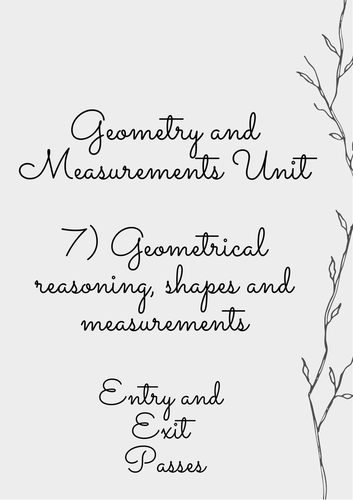

Entry and Exit pass for:
Geometry and Measurements - Geometrical reasoning, shape and measurement.
Made for Cambridge Primary Mathematics Curriculum for stage 2. (New edition 0096)
Suitable for Y2 National Curriculum England and Grade 1/2 American curriculum.
LOs:
2Gg.01 Identify, describe, sort, name and sketch 2D shapes by their properties, including reference to regular polygons, number of sides and vertices. Recognise these shapes in different positions and orientations.
2Gg.02 Understand that a circle has a centre and any point on the boundary is at the same distance from the centre.
2Gg.03 Understand that length is a fixed distance between two points. Estimate and measure lengths using non-standard or standard units.
2Gg.04 Draw and measure lines, using standard units.
2Gg.05 Identify, describe, sort and name 3D shapes by their properties, including reference to number and shapes of faces, edges and vertices.
2Gg.06 Understand that mass is the quantity of matter in an object. Estimate and measure familiar objects using non-standard or standard units.
2Gg.07 Understand that capacity is the maximum amount that an object can contain. Estimate and measure the capacity of familiar objects using non-standard or standard units.
2Gg.08 Identify 2D and 3D shapes in familiar objects.
2Gg.09 Identify a horizontal or vertical line of symmetry on 2D shapes and patterns.
2Gg.10 Predict and check how many times a shape looks identical as it completes a full turn.
2Gg.11 Understand that an angle is a description of a turn, including reference to the terms whole, half and quarter turns, both clockwise and anticlockwise.
2Gg.12 Understand a measuring scale as a continuous number line where intermediate points have value.
Please note that these quizzes are split into two parts:
Quiz 1 and 2 focuses on shapes and symmetry.
Quiz 3 and 4 focuses on measurement and direction and movement.
Something went wrong, please try again later.
This resource hasn't been reviewed yet
To ensure quality for our reviews, only customers who have purchased this resource can review it
Report this resourceto let us know if it violates our terms and conditions.
Our customer service team will review your report and will be in touch.